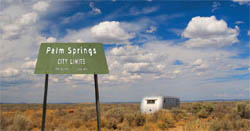
In the late 1800s, the area now known as Palm Springs, California was evenly divided by the federal government into a checkerboard of 1-mile square blocks. Property rights were assigned in alternating blocks to the Southern Pacific Railroad and to the Agua Caliente band of Cahuilla Indians. From then until the late 1950s, federally imposed restrictions on the sale and lease of the Agua Caliente Reservation land created high costs of developing the land. These costs impeded investment and sharply reduced the value of tribal lands. In contrast, the non-Indian blocks of Palm Springs assigned to Southern Pacific had fee-simple ownership status, making them free of such restrictions. Development proceeded on this property, resulting in land values more than five times higher than observed for otherwise identical Indian land. In the 1950s, the restrictions on Agua Caliente lands were relaxed and development on them soared. Not surprisingly, once development became feasible, the value of these lands rose rapidly, eventually converging with the value of non-Indian lands in Palm Springs.
The origins of the restrictions on the transferability of Indian lands dates backs to the nineteenth century. Although the lands assigned to the Agua Caliente tribe nominally belonged to individual members of the band, they were held in trust by the U.S. government. As a practical matter, trust lands could not be sold and, until 1955, legally could not be leased to developers or others for more than five years. Hence, the land effectively could not be used as collateral for loans that would enable the tribe to develop it. Moreover, non-tribal members were unwilling to invest their own funds in projects to which they would lose their rights after only five years. The result was that by the late 1950s, Palm Springs was a checkerboard of two different worlds. Non-Indian, fee-simple land had expensive homes and prosperous businesses located on it, and sold for high prices. Agua Caliente land stagnated in value and was largely undeveloped except in low-value residential uses, such as mobile homes.
In 1955 the U.S. government granted tribal members permission to lease their land for 25 years; in 1959 the government increased the maximum lease duration to 99 years and made it feasible for tribal members to sell their land holdings. Developers could now be assured of receiving full return on their projects, and the result was an explosion of both residential and commercial development activity on Agua Caliente lands. Over the next half century, the value of the Agua Caliente lands rose from a mere 13 percent of the value of neighboring fee-simple lands to parity. Today tribal and non-tribal lands in Palm Springs are virtually indistinguishable, both in appearance and in market value.
The transformation brought about by the enhanced transferability of Agua Caliente lands is useful in helping us understand two broader issues. First, the economic condition of American Indians lags considerably behind most of the rest of the American population. Per capita income among Indians is not much more than half the national average, and the poverty rate is roughly double the average. There are many reasons for this, but, as Terry Anderson and others have shown, one key element lies in legal institutions that limit the ability of Indians to sell or lease their lands or to use it as collateral. Akee’s research adds importantly to our understanding of the destructiveness of such restrictions.
The second lesson of this Agua Caliente story can be found in the use of property rights to protect the environment. It is becoming increasingly accepted, for example, that individual fishing quotas (IFQs) are the single most important tool for efficiently and effectively protecting the world’s fisheries. One crucial element of achieving the maximum performance from IFQs is that they be transferable, through both lease and sale. But not all IFQ systems permit unrestricted transfer, a fact that impairs the power of such systems to protect fisheries. Similarly, in a world of growing water scarcity, government-imposed restrictions on transferability of water rights don’t merely reduce economic efficiency; they threaten the survival of many aquatic species dependent on that water. Environmental damage is also caused by restrictions on the full transferability of federal grazing permits, restrictions that impede the movement of permitted lands out of grazing and into habitat protection.
Clearly defined, secure, transferable property rights are a necessary element of the voluntary exchange on which human prosperity is founded. But such rights are also our best hope for protecting and enhancing the environment. The Agua Caliente story makes it clear that property rights that are not transferable make mockery of the concept of property rights, a mockery that in other venues threatens species and degrades environmental quality. For those interested in environmental protection, it is a lesson we ignore at our peril.
REFERENCE
Akee, Randall. 2009. Checkerboards and Coase: The Effect of Property Institutions on Efficiency in Housing Markets. Journal of Law and Economics 52(2): 395–410.




